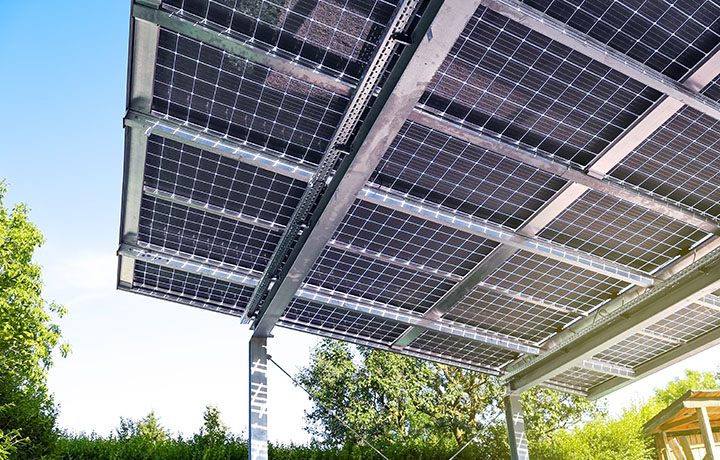
Part 1: Why Consider Distributed Solar Solutions?
Renewable energy projects continue taking hold as developers and municipalities strive to meet 2030 clean energy goals. But large, industrial-scale projects aren’t the only solution to meet the government’s clean energy goals. Part 1 of this two-article series on solar initiatives outlines the benefits of implementing distributed solar projects – community, commercial and industrial, and residential solar near the point of use.
President Biden’s climate goals require 80% clean electricity by 2030, 50% economy-wide carbon reductions by 2030, 95% economy-wide carbon reductions by 2050, and 100% electrification of the economy by 2050.
Local communities are taking part by installing small-scale clean energy technologies, like solar photovoltaic (PV) solutions, to increase their resilience while attracting environmentally conscious residents.
A few ways local communities are incorporating solar panels:
- Buildings – entrances, rooftops, facades, canopies, curtain walls, and more integrated on public, municipal, commercial, and residential buildings.
- Parking lots – locations like an airport, a car dealership, or commercial parking lot that shelters vehicles from the elements could provide shelter while creating energy.
- Transit shelters – freestanding, solar-powered bus shelters charge mobile phones, provide backlit signage, feature integrated LED lighting, and are Bluetooth enabled.
- Park pavilions, picnic table awnings, and pergolas – these stations provide outlets and mobile device charging capabilities for outdoor work zones and classrooms.
Economic Benefits of Distributed Solar
Locally produced solar provides homeowners, renters, municipalities, and businesses equal access to the cost-saving benefits of solar energy. For on-site solar systems tied into the power grid, all power produced reduces monthly utility bills, and these savings over time result in a significant return on investment. Off-grid solar structures with battery storage can have positive financial impacts for local economies as well.
Solar Panel Cost Effectiveness
According to Fast Company, solar electricity prices have dropped by 89% over the last 10 years, making it the lowest-cost source of electricity. Lower upfront capital costs result in solar PV systems paying for themselves in fewer years.
Increased Solar Panel Efficiency and Novel Applications
Advancements like double-sided (bifacial) solar panels have resulted in significant energy production gains by capturing reflected sunlight hitting the back side. Future energy efficiency gains appear to be coming from perovskite materials as well. Single-sided (monofacial) solar PV panels can be mounted on existing structures, and double-sided (bifacial) panels can be installed wherever light might hit or reflect onto the backside of the panels to produce more power.

Falling Battery Storage Costs
Prices continue to drop on the cost of battery storage. A report from the U.S. Energy Information Administration says, “Average battery energy storage capital costs in 2019 were $589 per kilowatt-hour (kWh), and battery storage costs fell by 72% between 2015 and 2019, a 27% per year rate of decline.”
Increased EV Adoption
Solar PV carports or pavilions paired with electric vehicle (EV) charging stations provide shelter while supporting clean transportation initiatives. Electrified vehicles cost less to operate and maintain than internal combustion engines, and they use energy more efficiently. Up-front costs for these vehicles are falling, and new products are being announced weekly.

New Source of Revenue Generation
Solar structures and EV chargers at commercial establishments can each drive sales and may even generate advertising revenue to help offset operating and maintenance costs.
How Renewables Benefit Society
Beyond the financial benefits, using renewable energy enriches the lives of people in the community by positively affecting society in the ways described below.
Improved Health and Safety
Research proves that renewables improve air quality, reduce carbon emissions, and lower noise levels. Solar canopies protect people and/or parked vehicles from harsh elements like sun, rain, and snow. Pairing these canopies with publicly accessible EV or phone chargers can even encourage recreation when they are installed at public parks and playgrounds.
Increased Resiliency
Local renewables help offset peak energy demand, particularly on hot summer days when energy demands reach their maximum. This builds resiliency amid increasingly extreme weather events that stress the infrastructure.
Added Convenience
EV charger installations provide convenience to customers at commercial and public establishments, saving valuable time. EV charging stations provide an additional perk to employees when installed at the workplace.
Aesthetics
Bifacial solar PV panels provide decorative, architectural elements in entranceways, rooftops, and shelter structures. Solar structures can even provide drivers with a clear, visual identification of EV charging stations. Companies like Lumos Solar and Spotlight Solar are reinventing the aesthetics of these technologies and incorporating weatherproofing, glass, infinity edges, and concealed conductors for a more seamless look.
Align Renewable Opportunities with Like Projects
Given the benefits of distributed renewable energy, the next step is to address the hurdles that may impede your progress. Project funding is almost always the first hurdle a community or developer encounters – the project must make good financial sense in order for it to receive support. Residents and municipal leaders constantly face competing priorities – it’s difficult to fund one project at the expense of another. Aligning a renewable project with an existing project is one way to go about it. Let’s say that a town is planning a new waterfront redevelopment project that includes streetscape, bicycle repair stations, ADA accessibility, parking lot improvements, and interpretive signage. Adding an EV charging station with solar PV makes sense since it aligns with the project’s overall goals. Look for additional funding sources that support the project, like the Michigan Mobility Funding Platform. Each community’s priorities and vision must be considered while developing your approach. The renewable piece of the project should provide tangible value, otherwise, it’s like fitting a square peg into a round hole.
It’s Time to Consider Solar Photovoltaics
With 60+ wind, solar, and battery projects under our belt, the Renewable Energy team at Metro Consulting helps guide communities through site selection, permitting, funding, engineering, and more. Contact us today to discuss your renewable energy project.

Stay connected!
Subscribe to News + Ideas

